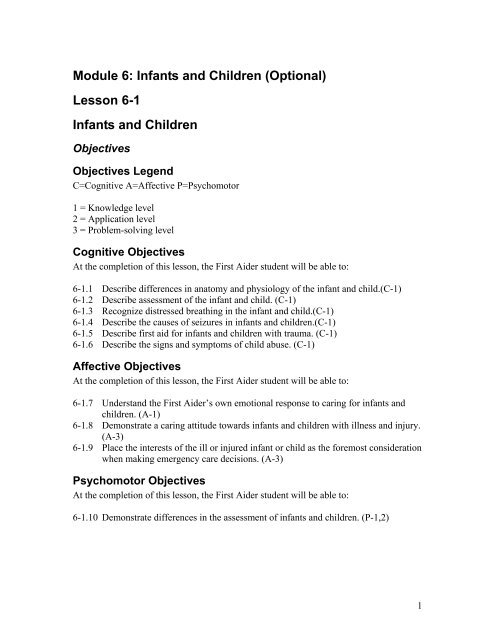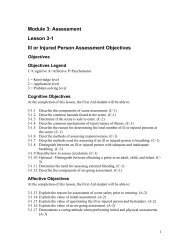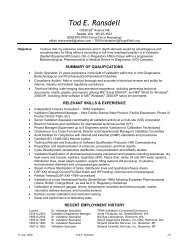First Aid 6
First Aid 6
First Aid 6
You also want an ePaper? Increase the reach of your titles
YUMPU automatically turns print PDFs into web optimized ePapers that Google loves.
PreparationMotivation:While first aid for infants and children in a general industry setting is unusual, many <strong>First</strong><strong>Aid</strong>ers, as a result of their training, will appreciate the potential for using their knowledgeand skills on infants or small children. A <strong>First</strong> <strong>Aid</strong>er who is suddenly confronted with anill or injured infant or child outside the confines of the occupational environment wouldbe more calm, prepared and skillful when dealing with life-threatening childhoodemergencies (as they are often emotionally difficult), were they to be more familiar withthe special needs of infants and children.While this module is an optional portion of these guidelines, being familiar with thespecial needs of infants and children may be viewed as a moral necessity for programdevelopers, instructors and/or employers who are driven not only by occupationalregulation, but by the broader humanitarian aspects of first aid.Aside from a general industry setting, certain other persons may be required by jobdescription, rule, policy, custom or public perception to receive adequate first aid trainingfor infants and children. These persons may include (but are not necessarily limited to)schoolteachers, childcare workers, corrections officers, line of duty police officers,firefighters and pool and ocean lifeguards.Prerequisites:Preparatory, Airway, Patient Assessment ModulesMaterialsAV Equipment:Utilize various audio-visual materials relating to first aid. The continuous development ofnew audio-visual materials relating to first aid requires careful review to determine whichbest meet the needs of the program. Materials should be edited to ensure that theobjectives of these guidelines are met.Equipment:None.Recommended Minimum Time to Complete:See Page 12 of Instructor’s Course GuidePresentationDeclarative (What)I. Anatomical and Physiological ConcernsA. Small airways are easily blocked by secretions and swelling.B. Tongue is large compared to mouth and airway.2
II.C. Positioning the airway is different in infants and children. Do not tilt the headback.D. Infants and children can compensate well for short periods of time.1. They compensate by increasing breathing rate and effort.2. When compensation mechanisms fail, children deteriorate rapidly.E. Keep infants and children warm.AirwayA. Essential skills-review Module 2-1, Airway, with emphasis on infants andchildren.1. Airway opening.a. Position to open airway is different; Head-neutral, chin-lift.b. Place hand or soft material under shoulders to assist in maintaining airwayposition (non-trauma).c. Head-neutral with chin-lift. Stabilize the head (trauma).2. Clearing complete obstructions.See "Pediatric Basic Life Support " in the most current version of the Emergency CardiacCare Committee and Subcommittees, American Heart Association. Guidelines forcardiopulmonary resuscitation and emergency cardiac care (JAMA).III.AssessmentA. Be sure to involve the parents or care-giver in your assessment and first aid careof infants and children.1. Agitated parents equal agitated child.2. Calm parents equal calm child.B. General impression of well versus sick child can be obtained from overallappearance.1. Assess level of responsiveness.2. Effort of breathing.3. Color4. Quality of cry or speech.5. Interaction with environment or parents/caregivers.a. Normal behavior for child of this age?b. Playing?c. Moving around?d. Attentive?e. Eye contact?f. Recognizes parents/caregivers?6. Emotional state (crying, upset, scared).7. Response to the <strong>First</strong> <strong>Aid</strong>erC. Approach to Evaluation1. Observe as you approach.a. Mechanism of Injuryb. Assess surroundingsc. Breathing assessment includes;(1) Breathing effort.3
e. Monitor pulse - heart may stop. Be prepared to provide external chestcompressions.C. Seizures1. Seizures, including those caused by fever, should be considered potentiallylife threatening.2. May be brief or prolonged.3. Caused by a variety of conditions;a. Decreased oxygen to the brain.b. Feverc. Infections.d. Poisoning.e. Low blood sugar.f. Trauma.g. Shock.h. Could be unknown cause in children.4. Role of the <strong>First</strong> <strong>Aid</strong>era. Complete the <strong>First</strong> <strong>Aid</strong>er assessment.(1) Complete a scene assessment and use appropriate BSI before initiatingfirst aid.(2) Complete an initial assessment on all ill or injured infants andchildren.(3) Assure that EMS is activated.(4) Complete the physical assessment (optional).(5) Complete on-going assessments.b. Comfort, calm, and reassure the infant/child while awaiting EMS.(1) Protect the infant/child from the environment.(2) Protect modesty - ask bystanders to leave the area.(3) Assure an open airway.(4) Assess for injuries that may have occurred during the seizure.(5) Place infant/child in the recovery position if no possibility of spinetrauma.(6) Never restrain the person.(7) Do not put anything in the infant/child 's mouth.(8) If the infant/child is bluish following seizure, assure an open airway,assess breathing and ventilate if infant/child is not breathing.(9) Report assessment findings to EMS.(10) Observe and describe the seizure to EMS.(a) <strong>First</strong> <strong>Aid</strong>er may be the only witness to seizure. This may help EMSdetermine the cause of seizure.D. Decreased level of responsiveness1. Caused by a variety of conditions.a. Low blood sugar.b. Poisoning.c. Post-seizure.d. Infection.e. Trauma.5
f. Shock.2. Role of the <strong>First</strong> <strong>Aid</strong>era. Complete the <strong>First</strong> <strong>Aid</strong>er assessment(1) Complete a scene assessment before initiating emergency medicalcare.(2) Complete an initial assessment on all ill or injured infants andchildren.(3) Assure that EMS is activated.(4) Complete the physical assessment (optional).(5) Complete on-going assessments.b. Comfort, calm, and reassure the infant/child while awaiting EMS.(1) Assure an open airway.(2) Be prepared to provide ventilations.(3) If non-trauma, place the infant/child in the recovery position.E. Sudden Infant Death Syndrome (SIDS)1. Signs and symptomsa. Most often occurs in the first six months of life.b. Cause is not clearly understood.c. Baby is most commonly discovered without signs of life after sleeping.2. Role of the <strong>First</strong> <strong>Aid</strong>era. Complete the <strong>First</strong> <strong>Aid</strong>er assessment(1) Complete a scene assessment before initiating emergency medicalcare.(2) Complete an initial assessment on all ill or injured infants andchildren.(3) Assure that EMS is activated.b. Make an effort to comfort, calm, and reassure the parents while awaitingEMS.(1) Even though resuscitation is unlikely, perform CPR.(2) Parents will probably be in great emotional distress.(3) Avoid comments suggesting parental blame.V. TraumaA. Injuries are the leading cause of death in infants and children.B. Blunt trauma is most common.C. There may be significant injuries without external signs.D. Consider the mechanism of injury and suspect internal injuries.E. Role of the <strong>First</strong> <strong>Aid</strong>er1. Complete the <strong>First</strong> <strong>Aid</strong>er assessmenta. Complete a scene assessment before initiating emergency medical care.b. Complete an initial assessment on all ill or injured infants and children.c. Assure that EMS is activated.d. Complete the physical assessment (optional).e. Complete on-going assessments.2. Comfort, calm, and reassure the infant/child while awaiting EMS.a. Assure an open airway and stabilize head and spine.b. Manually stabilize limb injuries if possible.6
VI. Child AbuseA. Abuse: Improper or excessive action causing injury or harm.B. Neglect: Insufficient attention or respect resulting in negative effects on theinfant’s/child’s well being.C. Some <strong>First</strong> <strong>Aid</strong>ers (e.g., law enforcement officers, daycare workers), may have alegal responsibility to report abuse/neglect to appropriate authorities.D. Considering the devastating and life-long consequences of child abuse, one mayconsider it a moral obligation to report suspected abusers to authorities.E. Sign and symptoms of abuse.1. Signs of repetitive injuries such as multiple bruises in various stages ofhealing.2. Injury inconsistent with mechanism described.3. Cigarette burns, whip marks and handprints on infant/child’s body.4. Injuries inconsistent with developmental stage.5. Changing story.6. Unexplained injury.F. Sign and symptoms of neglect.1. Lack of adult supervision.2. Malnourishment.3. Unsafe or unhealthy living environment.4. Untreated injury/illness.VII. DebriefingA. Serious injury or death of infant or child is usually emotionally difficult.B. Early recognition and consultation with an appropriately licensed mental healthprofessional may prevent more serious emotional/psychological difficulties for<strong>First</strong> <strong>Aid</strong>ers in these painful situations.ApplicationProcedural (How)1. Using a manikin, demonstrate the techniques of opening the airway in infants andchildren.2. Demonstrate ventilating infants and children.3. Demonstrate assessment of infants and children.4. Demonstrate the first aid for partial and complete airway obstructions in infants andchildren.5. Demonstrate the first aid for breathing problems in infants and children.6. Demonstrate the first aid for seizures and decreased level of responsiveness.Contextual (When, Where, Why)The <strong>First</strong> <strong>Aid</strong>er must have an understanding of the unique needs of infants and children.Since a child cannot be isolated from parents/care-givers, the emotions involved willprobably make providing first aid more stressful and/or difficult. A calm, caring attitudeis essential.7
Student ActivitiesAuditory (Hearing)1. The student should hear information on the special needs of infants and children.Visual (Seeing)1. The student should see visual representations of infants and children withinjury/illness.2. The student should see resuscitation barriers appropriate for infants and children.Kinesthetic (Doing)1. The student should practice opening the airway in infants and children.2. The student should practice ventilating infants and children.3. The student should practice assessment of infants and children.4. The student should practice the first aid for partial and complete airway obstructionsin infants and children.5. The student should practice the first aid for breathing problems in infants andchildren.6. The student should practice the first aid for seizures and decreased level ofresponsiveness.Instructor ActivitiesFacilitate discussion and supervise practice.Reinforce student progress in cognitive, affective, and psychomotor domains.Redirect students having difficulty with content.EvaluationEvaluate the actions of the <strong>First</strong> <strong>Aid</strong>er students during role play, practice or other skillstations to determine their comprehension of the cognitive and affective objectives andreasonable proficiency with the psychomotor objectives.RemediationIdentify students or groups of students who are having difficulty with this subject content.EnrichmentAddress unique student requirements or local area needs concerning this topic.8




